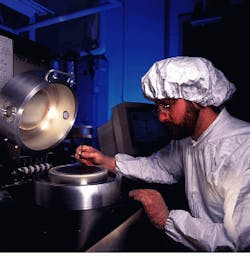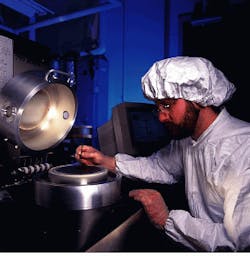Technology will keep us competitive
Technology will keep us competitive
Last October in an address at Boston University`s Photonics Center Inaugural Symposium, the author spoke on the need to develop "effective mechanisms to remain competitive in the global markets of tomorrow." In the first part of his speech, presented here slightly edited, Hebner notes the problems of transferring technology to the marketplace; next month he offers solutions to these problems.
Technology is driving growth at every level of our economy. Most economists now agree that three ingredients are essential to economic growth: capital, labor, and technology. Raw materials have become less significant. When we think of large modern economies, we think of the USA, of Japan, and of Germany. Although the USA still has appreciable stocks of raw materials, the others do not. If we agree on these three key ingredients of economic growth, we are forced to the sobering conclusion that all of these ingredients are highly mobile. We have no lock on economic leadership. We must continue to develop world-class workers and world-class technology if we hope to remain a world-class economy.
Technology is clearly the most important ingredient of economic growth. Leading economists estimate that technical progress has accounted for as much as one half of economic growth in the United States over the past 50 years. Of course, technology improves the productivity of labor. But leading economists who have analyzed the role of technical progress in the postwar period found a greater influence on the productivity of capital, and this is an area in which the United States has a natural advantage.
Since the Second World War, the USA has invested heavily in its research infrastructure. Today our universities, government laboratories, and industrial laboratories are among the world leaders. In fact, in October William Phillips of my institution, the National Institute for Standards and Technology (NIST), was one of three winners of the Nobel Prize in Physics for their pioneering work on laser cooling of atoms (see p. 103). This work in photonics research is important to physics today and will be important for measurement science in the future.
This year the federal government is investing about $25 billion to $30 billion in research that fuels this emerging technology. The funding is distributed among the National Science Foundation, the Departments of Defense and Energy, NASA, and the Department of Commerce, which includes both NOAA and NIST. This funding provides some of the support to government and university research facilities. We need to protect and to find ways to expand this investment as it pays huge dividends for our economy.
We see the growth-inducing power of technology at the industry level. Our research-intensive industries--aerospace, chemicals, communications, computers, pharmaceuticals, scientific instruments, semiconductors, and software--have been growing at about twice the rate of the economy as a whole in the past two decades.
We also see technology`s growth-inducing power at the level of the individual firm. A recent Commerce Department analysis shows that firms using advanced technologies are more productive and profitable, pay higher wages, and increase employment more rapidly than firms that do not. Specifically, in the study, employment at plants that used eight or more advanced technologies grew 14.4% more than plants that used no advanced technologies, and production workers` wages were more than 14% higher.
The evidence is convincing. At the macroeconomic level, the industry level, and the firm level, technology is the engine of economic growth. And the so-called enabling technologies are the most important factors in this economic growth equation. Throughout this century, enabling technologies--such as mass production, machine numerical control, and the transistor--have been powerful engines of growth. The integrated circuit is, perhaps, the defining enabling technology of the 20th century.
Since its invention 40 years ago, the integrated circuit has enabled a whole range of new products and industries--from the computer to satellite communications--and it has had a profound impact on existing products and processes from automobiles, consumer electronics, and home appliances to a broad range of advanced industrial systems. I would bet that, today, integrated circuits are involved as components or in the manufacture or delivery of nearly every product and service in a modern economy. The integrated circuit sowed seeds for the knowledge-based economy and the Information Age that are rapidly unfolding.
Enabling technologies spur growth
Today, we see vast opportunities in a range of new enabling technologies--advanced materials, digital imaging, high-performance computing, flexible manufacturing, biotechnology, and, of course, photonics. These technologies are improving US competitiveness in world markets through the introduction of new products and improvements in the cost, quality, and performance of existing products. They are critical to our national defense, and they are making strong contributions to health, human welfare, and the environment.
Enabling technologies also underpin many other technologies, with strong linkages to many segments of the economy. The great economic potential these technologies hold has been recognized around the world, and many nations have targeted them for development. This last point was brought home to me very clearly during a recent visit to Japan, where I learned that NTT has set itself a goal of making fiberoptic communication systems available to every home, office, and factory in the country for a price that does not exceed the cost of a copper-wire connection.
This decision, whether you choose to characterize it as enlightened foresight by a private company or inappropriate meddling in the market by the government, has had two effects, and the first is immediate. Photonics research and development are booming. NTT has set a price goal, a performance goal, and a deadline and is working mightily to develop the technology needed to meet those goals.
The second and likely more-important effect is that NTT is stimulating the development of electronic commerce. The company plans to make available sufficient bandwidth to permit a degree of electronic commerce that we only speculate about today. This communications infrastructure may make possible both new ways of doing business and new businesses.
Photonic technologies are also enabling the advanced products and services that are driving the Information Age. Thirty years ago, when I was in college, my professors advised me to pay attention to electro-optics because AT&T had just announced its commitment to an optical-fiber telephone system. Today`s $60 billion global photonics market spans applications in consumer electronics and computers, communications, automotive, defense and aerospace, health care, entertainment, and industrial fields. And the market is expected to grow substantially in the years ahead. My professors were right.
Obstacles to overcome
The United States has always been a world leader in photonics research. Yet that excellence in the laboratory does not always get translated into broad leadership in the marketplace. Reasons include challenges presented by an enabling technology`s investment and technology management dynamics.
Several years ago at a display conference in Hiroshima, Japan, an executive from a display company was reminiscing about how his company gained a dominant world share of the active-matrix liquid-crystal display market. He acknowledged that the company began with the very rudimentary displays invented in the USA, believing that these devices could really be important but that the company needed manufacturing experience and a revenue stream to allow continuous product improvement. The key insight was that digital watches could provide the market needed for continuous improvement and manufacturing experience, and today the company manufactures laptop displays--a market that did not exist just a few years ago.
This story, whether true or not, underscores a couple of points about technology development. First, it is very expensive to develop and commercialize an enabling technology. Second, an enabling technology`s multiple applications can exceed the product portfolios of most firms; an individual firm may not be able to justify the costly investment in R&D based on its segment of the technology`s potential market--unless it is smart enough to make cheap watches. That means that several different applications--often in different industries--need to be developed simultaneously. For example, the development of a new optoelectronic sensor for two end uses vs. 10 or 20 end uses can make a big difference in one`s ability to make it over the return-on-investment (ROI) hurdle.
Third, many enabling technologies--particularly in advanced electronics--are characterized by short life cycles. To stay competitive, a company may have to fund and manage many generations of technology simultaneously, some in full-scale production, some in pilot production, and some in manufacturing process design and development. This could be a company budget buster. It is also a challenge to company management to make the right technology decisions for competing technologies and product lines.
Fourth, enabling technologies are complex and multidisciplinary in nature. Bringing products and processes based upon them to market may require simultaneous advances and coordinated efforts in multiple R&D tracks, design, manufacturing, and marketing. Many scientific and technological disciplines may have to be mobilized.
In short, the cost and complexity of developing enabling technologies and bringing them to market may exceed the technical capabilities and financial resources individual firms can muster. Also, money and technical resources must come together under the increasing time pressures caused by global competition and rapid technological change. If you miss a technology change, you may never be able to regain market share. Moreover, as market share declines, the ability to muster the resources to catch up is diminished.
I don`t want to paint too bleak a picture. The problems may be monstrous, but solutions do exist. o
Next month, in the concluding segment of this Comment column, Robert Hebner offers solutions to the problems inherent in the transfer of technology from the laboratory to the marketplace.
Graduate student Dean Stocker works on a reactive ion etcher in a state-of-the-art optoelectronics research facility at Boston University`s Photonics Center. Companies that form product-development partnerships with the center have the same access to the laboratories and expertise of the university as the academic faculty.

